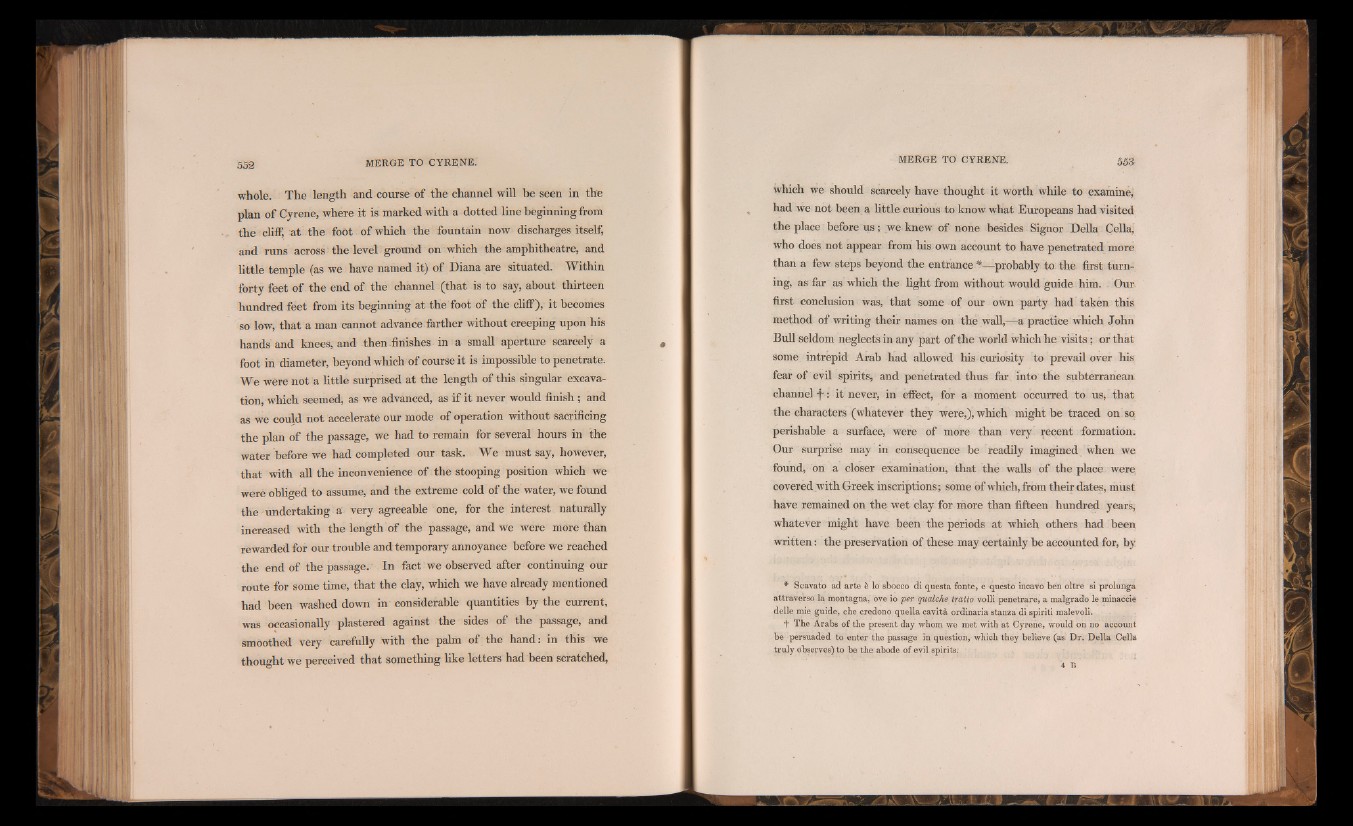
whole. The length and course of the channel will be seen in the
plan of Cyrene, where it is marked with a dotted line beginning from
the cliff, at the foot of which the fountain now discharges itself,
and runs across the level ground on which the amphitheatre, and
little temple (as we have named it) of Diana are situated. Within
forty feet of the end of the channel (that is to say, about thirtèen
hundred feet from its beginning at the foot of the cliff), it becomes
so low, that a man cannot advance farther without creeping upon his
hands and knees, and then finishes in a small aperture scarcely a
foot in diameter, beyond which of course it is impossible to penetrate.
We were not a little surprised at the length of this singular excavation,
which seemed, as we advanced, as if it never would finish ; and
as we could not accelerate our mode of operation without sacrificing
the plan of the passage, we had to remain for several hours in the
water before we had completed our task. We must say, however,
that with all the inconvenience of the stooping position which we
were obliged to assume, and the extreme cold of the water, we found
the undertaking a very agreeable one, for the interest naturally
increased with the length of the passage, and we were more than
rewarded for our trouble and temporary annoyance before we reached
the end of the passage. In fact we observed after continuing oür
route for some time, that the clay, which we have already mentioned
had been washed down in considerable quantities by the current,
was occasionally plastered against the sides of the passage, and
smoothed very carefully with the palm of the hand: in this we
thought we perceived that something like letters had been scratched,
which we should scarcely have thought it worth while to examine,
had we not been a little curious to know what Europeans had visited
the place before u s ; we knew of none besides Signor Della Celia,
who does not appear from his own account to have penetrated more
than a few steps beyond the entrance *—-probably to the first turning,
as far as which the light from without would guide him. Our
first conclusion was, that some of our own party had taken this
method of writing their names on the wall,—a practice which John
Bull seldom neglects in any part of the world which he visits; or that
some intrepid Arab had allowed his curiosity to prevail over his
fear of evil spirits, and penetrated thus far into the subterranean,
channel ■j' : it never, in effect, for a moment occurred to us, that
the characters (whatever they were,), which might be traced on so
perishable a surface, were of more than very recent formation.
Our surprise may in consequence be readily imagined when we
found, on a closer examination, that the walls of the place were
covered with Greek inscriptions; some of which, from their dates, must
have remained on the wet clay for more than fifteen hundred years,
whatever might have been the periods at which others had been
written: the preservation of these may certainly be accounted for, by
* Scavato ad arte 6 lo sbocco di questa fonte, e questo incavo ben oltre si prolunga
attraverso la montagna, ove io per qucdche tratto v.olli penetrare, a malgrado le minaccie
delle mie guide, che credono quella cavita ordinaria stanza di spiriti malevoli.
+ The Arabs of the present day whom we met with at Cyrene, would on no account
be persuaded to enter the passage in question, which they believe (as Dr. Della Celia
truly observes) to be the abode of evil spirits;
4 B
i li HI ■ ■ ||I